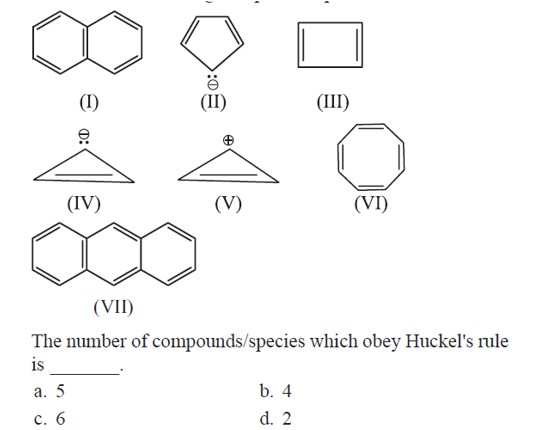P Block Elements
Get insights from 254 questions on P Block Elements, answered by students, alumni, and experts. You may also ask and answer any question you like about P Block Elements
Follow Ask QuestionQuestions
Discussions
Active Users
Followers
New answer posted
2 months agoContributor-Level 10
The highest oxidation number corresponding to the group number in transition metal oxides is attained in Sc? O? to Mn? O? CrO is basic but Cr? O? is amphoteric.
Note: All the transition metals except scandium form MO oxides which are ionic (Only for 3d series, this statement is true)
Hence, (A), (C) and (D) are incorrect. But not given in the options.
New answer posted
2 months agoContributor-Level 10
Acc. to Huckel rule, A compond/molecule is said to be aromatic if it have cyclic conjugate and [4n + 2]π electron system
⇒ Molecule must be sp² hybridised
⇒ Molecule must be planar.
New answer posted
2 months agoContributor-Level 10
Λ°? (CH? COOH) = Λ°? (H? ) + Λ°? (CH? COO? ) = 350 + 50 = 400Scm² mol? ¹
α = Λ? / Λ°?
α = 20/400 = 5 * 10? ²
K? (CH? COOH) = Cα²
= 0.007 * (5 * 10? ²)²
= 1.75 * 10? molL? ¹
New answer posted
2 months agoContributor-Level 10
Vitamin B? deficiency → Pernicious anaemia (RBC deficient in heamoglobin)
New answer posted
2 months agoContributor-Level 10
Oxidation state in neutral medium changes from +7 to +4 for MnO? to MnO?
New answer posted
2 months agoContributor-Level 10
I - Cl bond is stronger than I-I bond due to additional electrostatic force between I and Cl.
New answer posted
2 months agoContributor-Level 9
Solubility of CdSO? is water ; S = 8 * 10? M
Using Ksp = S²
Ksp = 64 * 10? M
Now,
CdSO? Cd²? + SO? ²?
in H? SO? (0.01M)
Ksp = [Cd²? ] [SO? ²? ]
64 * 10? = S? (S? + 0.01)
S? << 0.01
So, S? = 64 * 10? M.
New answer posted
2 months agoContributor-Level 9
Partial hydrolysis of XeF? gives XeO? F?
XeF? + 2H? O → XeO? F? + 4HF
Compound A is XeF? , so number of lone pair on Xe is 1.
New answer posted
2 months agoContributor-Level 10
In a C? fullerene molecule, all 60 carbon atoms are identical. Each carbon atom is bonded to three other carbon atoms via sigma bonds. The structure is composed of 20 six-membered rings and 12 five-membered rings.
New answer posted
2 months agoContributor-Level 10
Co (NH? )? ] [Cr (CN)? ]: Co-ordination isomerism
[Co (NH? )? (NO? )? ]: Linkage isomerism
[Cr (H? O)? ]Cl? : Solvate isomerism
Cis- [CrCl? (Ox)? ]³? : Optical isomerism
Taking an Exam? Selecting a College?
Get authentic answers from experts, students and alumni that you won't find anywhere else
Sign Up on ShikshaOn Shiksha, get access to
- 65k Colleges
- 1.2k Exams
- 679k Reviews
- 1800k Answers

